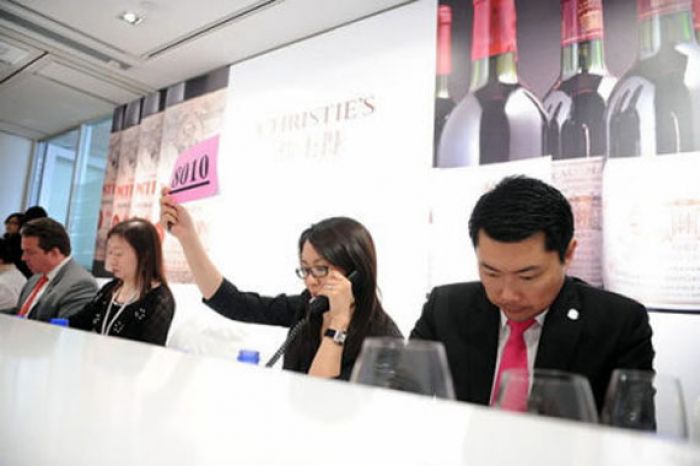
China’s market for fine wines is maturing and augmenting at a dizzying rate. Wine imports to Hong Kong are poised to break the US$1 billion barrier this year, after soaring by 65% in the first eight months of 2011. And that doesn’t even take the booming Mainland into consideration, a wine market valued at 75 billion Yuan (roughly US$10 billion) in 2009. Domestic wines still account for over two-thirds of the local market, but demand for imported grape wine is surging, as the rising middle class take more overseas travel, exposing them to western customs and wine culture.
 Not that interest is sudden. Chinese wine buyers were instrumental in the recovery at the top end of the market, following the dip seen in the wake of the global economic crisis in 2008. The Mainland is now the largest importer of Bordeaux by volume, edging out Germany and driving a jump in exports of French wine. According to Luxuo, exports from the famed French region rose 34 percent in value and 23 percent in volume between July 2010 and June 2011.
Not that interest is sudden. Chinese wine buyers were instrumental in the recovery at the top end of the market, following the dip seen in the wake of the global economic crisis in 2008. The Mainland is now the largest importer of Bordeaux by volume, edging out Germany and driving a jump in exports of French wine. According to Luxuo, exports from the famed French region rose 34 percent in value and 23 percent in volume between July 2010 and June 2011.
Messages regarding the market are mixed. Jing Daily recently reported that fine wine prices retreated 7.5 percent in the third quarter of 2011 and that demand for the highest of high-end bottles, particularly Chateau Lafite, were thought to be showing signs of slowing after a nearly three-year-long tear – due partly to the ubiquity, rampant counterfeiting and unsustainably high prices of Lafite and other high-profile wines.
Echoing this sentiment, prime lots of Chateau Lafite, Chateau Latour, Mouton Rothschild and Margaux failed to sell at Sotheby’s Finest and Rarest Wines sale last week in Hong Kong. It was the first auction not to sell out entirely since Sotheby’s entered Hong Kong in 2009. Yet over at Christie’s, just last September, an anonymous Chinese bidder bought 300 bottles of Château Lafite-Rothschild bundled into a single lot for $539,280 – the most expensive single lot sale this year.
Christie’s head of wine for China, Simon Tam, refused to become pessimistic, suggesting instead that the market is simply calming down. “The first generation of wine lovers to discover Lafite now have long-lasting stock and they don’t need to accumulate more.” Mathieu Chadronnier, managing director of CVBG Grands Crus, went so far as to say it was necessary. “We have gone through a period of constant growth. Prices can’t go on increasing forever – this correction was needed.”
 The buying landscape is clearly changing. In a first for the country, the Chinese government has approved the first-ever Chinese investment fund specialising in wine, which plans to invest over €110 on wine over a five-year period. Ling Zhijun, a banking professional and wine enthusiast who manages Pacific Asset Management of Beijing, founded the Dinghong Fund. Investors must part with a minimum investment of €1m for a company and €100,000 for an individual, and buying will be managed by Bordeaux negociant Vintex & les Vignobles Grégoire.
The buying landscape is clearly changing. In a first for the country, the Chinese government has approved the first-ever Chinese investment fund specialising in wine, which plans to invest over €110 on wine over a five-year period. Ling Zhijun, a banking professional and wine enthusiast who manages Pacific Asset Management of Beijing, founded the Dinghong Fund. Investors must part with a minimum investment of €1m for a company and €100,000 for an individual, and buying will be managed by Bordeaux negociant Vintex & les Vignobles Grégoire.
Philippe Larché, one of the partners in negociant Vintex and the fund’s primary advisor and main supplier, revealed that over one-third of wines to be purchased will supply the cellars of fund investors. “The fund is not just about buying and selling grands crus, but also educating customers and introducing them to Bordeaux,” he remarked. “We expect to bring each investor to discover the vineyards of Bordeaux, and to set up wine masterclasses in China, with the participation of owners and winemakers.”
Mr Larché remained relatively unfazed by recent results at the Sotheby’s auction, instead suggesting the result was indicative of a natural evolution in the market, as bidders understand more about wine and how it trades. He, alongside Sotheby’s worldwide head of wine, Serena Sutcliffe, suggested that Second Growths are becoming increasingly popular in Asia, as knowledge of different châteaux broadens.
“China now understands that we don’t have only first growths in Bordeaux. The market is maturing. But I am not anxious. I am very confident that the first growths will go up again in value.”









